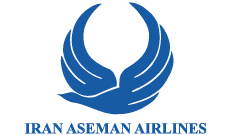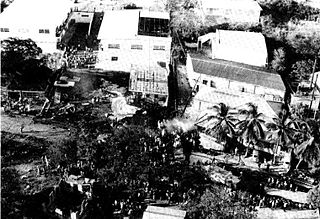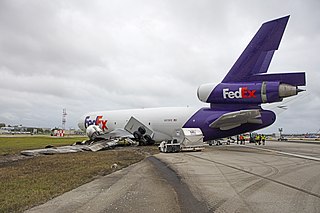
Allegheny Airlines was a regional airline that operated out of Pittsburgh, Pennsylvania, from 1952 to 1979 with routes primarily located in the eastern U.S. It was the forerunner of USAir that was subsequently renamed US Airways, which itself merged with American Airlines. Its headquarters were at Washington National Airport in Arlington County, Virginia.

Iran Aseman Airlines is the third-largest Iranian airline headquartered in Tehran. It operates scheduled domestic passenger services and regional international services.
Kazakhstan Airlines was an airline from Kazakhstan, serving as national flag carrier of the country from its independence in 1991 until 1996. Following the disaster of the Charkhi Dadri mid-air collision, Kazakhstan Airlines ceased operations, and its role as flag carrier was transferred to Air Kazakhstan.

American Airlines Flight 625, a Boeing 727-100, crashed at St. Thomas, U.S. Virgin Islands on April 27, 1976, while on a domestic scheduled passenger flight originating at T. F. Green Airport in Rhode Island and ending at Saint Thomas, United States Virgin Islands, with an intermediate stop at John F. Kennedy International Airport. 37 out of the 88 passengers on board died in the accident.

RUTACA Airlines is an airline headquartered in Ciudad Bolívar, Venezuela with its home base at Tomás de Heres Airport and a hub at Simón Bolívar International Airport in Caracas.
Compagnie Africaine d'Aviation, renamed FlyCAA in 2013, is a regional airline from the Democratic Republic of the Congo, based at N'djili Airport in Kinshasa. It offers an extensive network of domestic scheduled passenger flights, as well as cargo flights. Due to safety and security concerns, CAA has been included in the list of air carriers banned in the European Union.

In aviation, a water landing is, in the broadest sense, an aircraft landing on a body of water. Seaplanes, such as floatplanes and flying boats, land on water as a normal operation. Ditching is a controlled emergency landing on the water surface in an aircraft not designed for the purpose, a very rare occurrence. Controlled flight into the surface and uncontrolled flight ending in a body of water are generally not considered water landings or ditching.

The 1977 Aviateca Convair 240 airplane crash was a scheduled Aviateca passenger flight that crashed near Guatemala City, Guatemala on April 27, 1977. All 28 people on board survived, but the aircraft was destroyed.

As of July 2020, a total of 60 Boeing 747 aircraft, or just under 4% of the total number of 747s built, first flown commercially in 1970, have been involved in accidents and incidents resulting in a hull loss, meaning that the aircraft was either destroyed or damaged beyond economical repair. Of the 60 Boeing 747 aircraft losses, 32 resulted in no loss of life; in one, a hostage was murdered; and in one, a terrorist died. Some of the aircraft that were declared damaged beyond economical repair were older 747s that sustained relatively minor damage. Had these planes been newer, repairing them might have been economically viable, although with the 747's increasing obsolescence, this is becoming less common. Some 747s have been involved in accidents resulting in the highest death toll of any civil aviation accident, the highest death toll of any single airplane accident, and the highest death toll of a midair collision. As with most airliner accidents, the root of cause(s) in these incidents involved a confluence of multiple factors that rarely could be ascribed to flaws with the 747's design or its flying characteristics.

Allegheny Airlines Flight 485 was a regularly scheduled domestic passenger flight between Washington, D.C. and Newport News, Virginia, United States, with three stop-overs, two in Connecticut and a third in Pennsylvania. On June 7, 1971, the Allegheny Airlines Convair CV-580 operating the flight crashed on approach to Tweed New Haven Regional Airport, New Haven County, Connecticut.

On December 27, 1968, North Central Airlines Flight 458 crashed into a hangar while attempting a night landing in poor weather at O'Hare International Airport in Chicago, Illinois, in the United States. Of the 41 passengers and four crew members, only 17 passengers and one crew member survived. One person was killed and six were injured on the ground.

On December 20, 1972, North Central Airlines Flight 575 and Delta Air Lines Flight 954 collided on a runway at O'Hare International Airport in Chicago, Illinois, in the United States. Ten people died – all on the North Central aircraft – and 17 were injured in the accident. This was the second major airliner accident to happen in Chicago in December 1972; the other was United Airlines Flight 553, which crashed twelve days earlier on approach to Midway Airport.

Allegheny Airlines Flight 737 was a Convair CV-580, that crashed while attempting to land at Bradford Regional Airport in Bradford, Pennsylvania on January 6, 1969. Eleven of the 28 occupants on board were killed.

On October 28, 2016, FedEx Express Flight 910, a McDonnell Douglas MD-10-10F flying from Memphis International Airport to Fort Lauderdale–Hollywood International Airport was involved in a runway skid after a landing gear collapse, which resulted in a fire completely destroying the left engine and wing. Two crew members, the only people on board, were unharmed.

Delta Air Lines Flight 9877 was a crew training flight operated on a Douglas DC-8. On March 30, 1967, it lost control and crashed into a residential area during a simulated engine-out approach to Louis Armstrong New Orleans International Airport.













